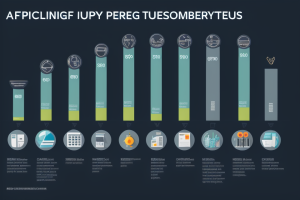
Usage Intensity: A Concept That Defines Our Daily Lives
Have you ever wondered how we use technology and resources in our daily lives? Well, usage intensity is the measure of how much we rely on technology and resources in our daily lives. It is a concept that helps us understand how much we use and depend on things like smartphones, laptops, cars, and even electricity. In this article, we will explore what usage intensity is and how it impacts our daily lives. From the amount of time we spend on our devices to the energy we consume, usage intensity plays a crucial role in our lives. So, let’s dive in and discover how this concept defines our daily lives.
Usage intensity refers to the amount of a particular resource that is used in a given period of time. This can apply to various resources such as energy, water, or even time. The impact of usage intensity on our daily lives can be significant. For example, if a household uses a lot of electricity, their energy bills will be higher. Similarly, if a person spends a lot of time on their phone, they may be missing out on other activities or spending less time with friends and family. By being aware of our usage intensity, we can make conscious decisions to reduce our consumption and save resources, which can have a positive impact on both our wallets and the environment.
What is Usage Intensity?
Definition
- A measure of the level of utilization of assets or resources in the production process
- It indicates how intensively resources are being used to produce goods and services
Usage intensity is a key concept in the field of productivity and efficiency. It refers to the degree to which resources, such as labor, capital, and technology, are utilized in the production process. In other words, it measures the extent to which these resources are being used to their full potential.
One way to think about usage intensity is to consider the output per unit of input. For example, if a factory is producing 100 units of a product in a day using 10 workers, the usage intensity would be 10 units per worker. If the same factory were to increase its output to 150 units using the same number of workers, the usage intensity would be 15 units per worker, indicating a higher level of productivity.
Usage intensity is an important factor in determining the competitiveness of a business or economy. When resources are used more efficiently, it can lead to lower costs, higher quality products, and increased profitability. Conversely, low usage intensity can result in inefficiencies, wasted resources, and reduced competitiveness.
Moreover, usage intensity can also have implications for sustainability. If resources are used intensively but not efficiently, it can lead to waste and environmental degradation. Therefore, it is important to consider not only the level of usage intensity but also the quality of resource utilization in assessing the sustainability of production processes.
Factors affecting Usage Intensity
- Type of assets or resources being used: The type of assets or resources being used plays a significant role in determining usage intensity. For instance, the intensity of usage of machines and equipment will be higher than that of office furniture and fixtures.
- Technology employed in production: The level of technology used in production can have a significant impact on usage intensity. For example, the usage intensity of high-tech equipment is generally higher than that of low-tech equipment.
- Production process and methodology: The way in which production processes are carried out can also impact usage intensity. For example, a production process that involves continuous flow may have higher usage intensity compared to a process that involves batch production.
- Managerial efficiency and skill: The efficiency and skill of managers can also affect usage intensity. For example, a manager who is skilled in optimizing resources may be able to increase usage intensity without sacrificing productivity. On the other hand, a manager who is inefficient may result in lower usage intensity even if more resources are available.
Calculation of Usage Intensity
Calculation of Usage Intensity is a method used to determine the efficiency of resource utilization in an industry or firm. It is a key indicator of how effectively resources are being used to produce goods and services. The calculation of Usage Intensity involves dividing the total costs of intermediate consumption by the total value of output. This ratio provides valuable insights into the productivity of a particular industry or firm, and can be used to compare performance with similar industries or firms. By identifying trends and areas for improvement, businesses can optimize their resource utilization and improve their overall efficiency.
Impact of Usage Intensity on Our Daily Lives
Environmental Implications
Usage intensity refers to the rate at which a resource is used or consumed. It is an important concept in understanding the impact of our daily activities on the environment. High usage intensity often leads to increased pollution and depletion of natural resources. For example, a high usage intensity of fossil fuels contributes to increased carbon emissions and climate change. Similarly, a high usage intensity of water resources can lead to water scarcity and depletion of aquifers.
Reducing usage intensity can help reduce environmental damage and promote sustainability. For instance, reducing the usage intensity of energy through energy efficiency measures can lower greenhouse gas emissions and reduce the demand for fossil fuels. Similarly, reducing the usage intensity of water through water-saving technologies and practices can help conserve this vital resource.
In conclusion, understanding and reducing usage intensity is essential for promoting sustainability and mitigating the negative impacts of our daily activities on the environment.
Economic Implications
- Usage intensity is a measure of the amount of a resource that is used in relation to its availability. It is a critical factor in understanding the economic implications of various industries and businesses.
- Competitiveness of businesses and industries: Usage intensity affects the competitiveness of businesses and industries by determining the level of resource utilization required to produce goods and services. For example, industries with high usage intensity tend to have higher production costs and require more resources, making them less competitive in the market.
- High usage intensity can lead to higher costs and lower profitability for firms: High usage intensity can result in increased production costs for firms, which can lead to lower profitability. This can impact the ability of firms to compete in the market and can result in job losses and other negative economic consequences.
- Impact on employment and wages: Usage intensity can also impact employment and wages in an economy. For example, industries with high usage intensity tend to require more workers, which can lead to higher employment levels and higher wages. However, if usage intensity leads to higher production costs, it can also result in job losses and lower wages.
In conclusion, the economic implications of usage intensity are complex and far-reaching. Understanding how usage intensity affects businesses and industries is crucial for policymakers and business leaders who are looking to promote economic growth and competitiveness.
Social Implications
Usage intensity can have significant social implications on individuals and communities. Here are some ways in which it can impact the quality of life:
- Access to Essential Goods and Services: Usage intensity can affect the availability of essential goods and services such as healthcare and education. For instance, areas with high usage intensity may have better access to healthcare facilities and more specialized medical services. Similarly, areas with high usage intensity may have better-funded schools and universities, providing students with better educational opportunities.
- Equitable Distribution of Resources and Benefits: Reducing usage intensity can lead to a more equitable distribution of resources and benefits. For example, reducing energy usage intensity can help reduce energy poverty, where low-income households struggle to afford energy costs. Additionally, reducing resource usage intensity can help conserve natural resources, which can benefit communities that rely on these resources for their livelihoods.
- Social Inequality: Usage intensity can also contribute to social inequality. For example, areas with high usage intensity may have higher levels of income inequality, as only those who can afford high levels of consumption can access the best services and products. This can create a divide between rich and poor communities, with wealthier communities having better access to essential goods and services.
- Environmental Impact: Usage intensity can also have an environmental impact. For example, areas with high energy usage intensity may have higher levels of air pollution, as the burning of fossil fuels to generate electricity can release harmful emissions into the atmosphere. This can have a negative impact on the health of individuals living in these areas, particularly those with respiratory conditions.
Overall, usage intensity can have significant social implications on individuals and communities. By understanding these implications, we can work towards reducing usage intensity and promoting more equitable access to essential goods and services.
Future Trends and Opportunities
As technology continues to advance and sustainability becomes a more pressing concern, the future of usage intensity holds both challenges and opportunities. Here are some of the trends and opportunities that are likely to shape the future of usage intensity:
- Technological advancements and innovation can reduce usage intensity while increasing productivity. Advancements in technology such as artificial intelligence, the Internet of Things, and robotics can help us use resources more efficiently by automating processes, reducing waste, and optimizing production. For example, predictive maintenance using IoT sensors can help identify equipment failures before they occur, reducing downtime and increasing efficiency.
- Adoption of sustainable practices and circular economy principles can lead to reduced resource consumption and waste. The circular economy is an economic model that aims to eliminate waste and the continual use of resources. This model encourages the reuse and recycling of materials, which can help reduce resource consumption and waste. For example, companies can adopt a closed-loop supply chain, where materials are continually reused and recycled, reducing waste and resource consumption.
- Development of new business models and markets can promote more efficient and sustainable usage of resources. New business models such as the sharing economy and product-service systems can promote more efficient and sustainable usage of resources. For example, car-sharing programs can reduce the number of cars on the road, which can help reduce traffic congestion and air pollution. Additionally, the development of new markets for sustainable products can promote more sustainable production and consumption patterns.
In conclusion, the future of usage intensity holds both challenges and opportunities. As technology continues to advance and sustainability becomes a more pressing concern, we must embrace new business models and markets, adopt sustainable practices, and take advantage of technological advancements to reduce resource consumption and waste. By doing so, we can create a more sustainable and efficient future for ourselves and future generations.
FAQs
1. What is usage intensity?
Usage intensity refers to the rate at which a particular resource or utility is consumed or utilized over a given period of time. It is a measure of how much of a particular resource is used in relation to its availability or capacity.
2. How does usage intensity impact our daily lives?
Usage intensity can have a significant impact on our daily lives. For example, if a household has high usage intensity for electricity, it may result in higher energy bills and a greater environmental impact due to increased carbon emissions from power generation. Similarly, high water usage intensity can lead to water scarcity and increased water bills. Understanding usage intensity can help individuals and households make more informed decisions about resource consumption and conservation.
3. How is usage intensity measured?
Usage intensity is typically measured as a ratio or a percentage. For example, if a household uses 100 units of electricity in a month, and the total capacity of the grid is 1000 units, the usage intensity would be 10%. The unit of measurement may vary depending on the resource being considered, such as kilowatt-hours for electricity or gallons per minute for water.
4. What factors can affect usage intensity?
Several factors can affect usage intensity, including population density, lifestyle habits, technological advancements, and economic conditions. For instance, a densely populated area may have higher usage intensity for resources such as water and electricity due to increased demand. Similarly, households with a high consumption of electronics and appliances may have higher usage intensity for electricity. Understanding these factors can help individuals and communities make more informed decisions about resource use and conservation.
5. How can usage intensity be reduced?
There are several ways to reduce usage intensity, including adopting energy-efficient appliances and electronics, using natural lighting and ventilation, reducing water usage through efficient fixtures and irrigation systems, and using public transportation or carpooling to reduce fuel consumption. Additionally, individuals can make a conscious effort to reduce waste and recycle materials, which can also reduce resource consumption and lower the impact on the environment.







